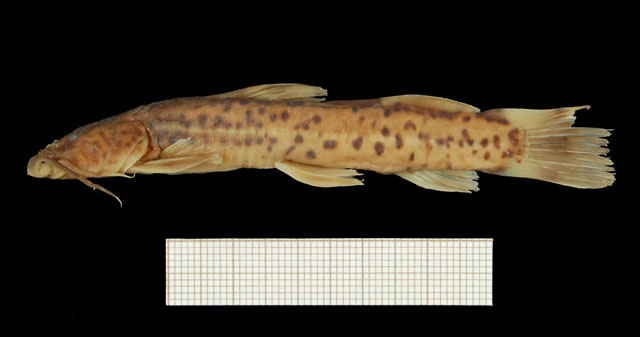|
Dorsal spines (total): -0; Anal spines: -0. Diagnosis: caudal fin without large black spot; body light brown with clear large spots; origin of dorsal fin less than one head length behind head; dorsal fin base extends behind origin of pelvic fin origin; dorsal fin leading ray distinctly shorter than leading edge of fin; caudal fin with 6+7 principal rays; caudal peduncle 1.2-1.5 times longer than deep; snout equal to or shorter than post-orbit length, less than half length of head; eyes placed equidistant from hind margin of head and tip of snout (mid-way along head) or nearer to tip of snout (Ref. 81646).
Description: body depressed and ovoid in cross-section anteriorly, caudal peduncle compressed; head length 3.8-4.25 times in SL; head longer than wide, depressed, flat below; branchiostegal membrane deeply cleft in mid-line; mouth broad, subterminal; lips fleshy; teeth caniniform in pad on premaxillae and band on mandible; barbels filamentous, maxillary longest, reaches base of pectorals; nostrils in mid-snout, separated; eyes small, moderately widely spaced (interorbital width 2.3-3.4 times orbit diameter), confluent with head (orbits without free margins); caudal peduncle short, 5.9-6.8 times in SL; fins well-developed; dorsal fin base extends to above origin of pelvics; dorsal fin rectangular with straight hind edge, leading ray shorter than leading edge of fin; pectoral and pelvic fins about equal size, large and rounded, with curved pectinate and padded first ray; pectoral not reaching pelvics, pelvics not reaching anal origin; anal short-based and rounded, nearly reaching base of caudal; caudal large, truncate or slightly emarginate, crenellated fleshy pad over base; adipose fin long, low, extending from before origin of anal to procurrent ridge of caudal; anus and genital pore close behind pelvics (Ref. 81646).
Coloration: light brown with dark brown spots and vermiculated markings dorsally and laterally; intensity of spots varies individually, some specimens considerably more spotted than others; creamy ventrally from head to anal fin; fins plain pale brown or clear with occasional spots, caudal fin light brown, with a faint mid-band or bar (Ref. 81646). |

